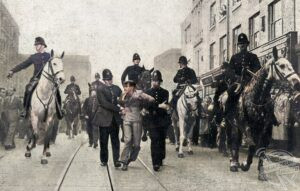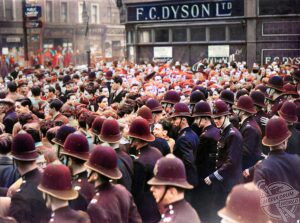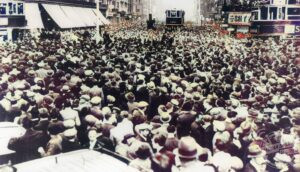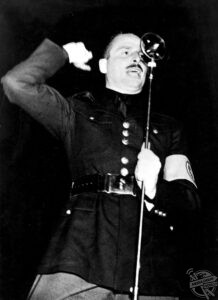By Aimee Braniff Cree
**WITH FULL PERMISSIONS**
COLOURISED IMAGES of The Battle of Cable Street show what was previously the largest Anti-Semitism demonstration in history before last weekend’s rally in central London.
Images show demonstrators gathering, Sir Oswald Mosley addressing a fascist meeting in London and people being dragged away by police.
The Battle of Cable Street was a series of clashes that took place at several locations in the inner East End of London, most notably Cable Street, on Sunday 4th October 1936.

It was a clash between the Metropolitan Police, sent to protect a march by members of the British Union of Fascists led by Oswald Mosley, and various de jure and de facto anti-fascist demonstrators, including local trade unionists, communists, anarchists, British Jews, supported in particular by Irish workers, and socialist groups.
The anti-fascist counter-demonstration included both organised and unaffiliated participants.
Very large numbers of people took part in the events, in part due to the good weather, but estimates of the numbers of participants vary enormously:
Estimates of Fascist participants range from 2,000 to 3,000, up to 5,000. The Fascists had a casualty dressing station at their Tower Hill assembly point.
There were 6,000–7,000 policemen, including the whole of the Metropolitan Police Mounted Division. The Police had wireless vans and a spotter plane sending updates on crowd numbers and movements to Sir Philip Game’s HQ, established on a side street by Tower Hill.

Estimates of the number of anti-fascist counter-demonstrators range from 100,000 to 250,000, 300,000, 310,000 or more. The Independent Labour Party and Communists, like the Fascists, set up medical stations to treat their injured.
About 150 demonstrators were arrested, with the majority of them being anti-fascists, although some escaped with the help of other demonstrators. Around 175 people were injured including police, women and children.
The anti-fascists celebrated the community’s united response, in which large numbers of East-Enders of all backgrounds; Protestants, Catholics and Jews successfully resisted Mosley and his followers. There were few Muslims in London at the time, so organisers were also delighted when Muslim Somali seamen joined the anti-fascist crowds.

The event is frequently cited by modern Antifa movements as “…the moment at which British fascism was decisively defeated”.
The Fascists presented themselves as the law-abiding party who were denied free speech by a weak government and police force in the face of mob violence. After the event the BUF experienced an increase in membership, although their activity in Britain was severely limited.

Following the battle, the Public Order Act 1936 outlawed the wearing of political uniforms and forced organisers of large meetings and demonstrations to obtain police permission. Many of the arrested demonstrators reported harsh treatment at the hands of the police.










